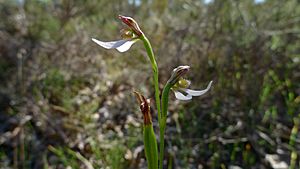Bunny orchids facts for kids
Quick facts for kids Bunny orchids |
|
|---|---|
 |
|
| Eriochilus dilatatus subsp. undulatus | |
| Scientific classification |
|
| Kingdom: | Plantae |
| Clade: | Tracheophytes |
| Clade: | Angiosperms |
| Clade: | Monocots |
| Order: | Asparagales |
| Family: | Orchidaceae |
| Subfamily: | Orchidoideae |
| Tribe: | Diurideae |
| Subtribe: | Caladeniinae |
| Genus: | Eriochilus R.Br. |
| Synonyms | |
|
Eriochilum Ritgen |
|
Eriochilus, often called bunny orchids, is a group of flowering plants in the orchid family. These special orchids are found only in Australia. You can tell them apart from similar orchids, like the Caladenia, because their leaves are smooth and their "lip" petal (called a labellum) is very fuzzy or woolly.
Bunny orchids grow in many parts of Australia, including Western Australia, South Australia, Queensland, New South Wales, the Australian Capital Territory, Victoria, and Tasmania. Their common name comes from their two large, ear-like side petals, which stick out like a bunny's ears!
Contents
What do Bunny Orchids Look Like?
Bunny orchids are perennial plants, meaning they live for more than two years. They grow from the ground and have a round, juicy underground part called a succulent tuber. This tuber helps them store food and water. New tubers grow from short "droppers" that hang down.
Each bunny orchid plant usually has just one smooth, egg-shaped leaf. This leaf can be at the bottom of the stem or in the middle.
The Flowers of Bunny Orchids
Bunny orchids have flowers that grow in a cluster along a stem, which is called a raceme. There can be up to 25 flowers on one stem. Each flower has a small leaf-like part called a bract at the bottom of its stalk.
The top petal, called the dorsal sepal, is smaller than the other two. It's shaped like a dish and bends forward to form a hood over the flower's "lip." The two side petals, called lateral sepals, are much bigger and more noticeable. They are usually white to pink and spread out, looking like the "ears" of a bunny.
Like most orchids, one petal is very different from the others. This is the central "lip" petal, or labellum. The other two petals are usually smaller and narrower than the sepals. They might stand up, spread out, or curve backward. The base of the labellum wraps around the lower part of the column (where the male and female parts of the flower are). The front of the labellum curves strongly downwards and is covered with tiny, glandular hairs. It often has spots too!
The parts of the flower that help it reproduce are joined together in a structure called the column. This column stands upright, is short, and has narrow, wing-like parts. Bunny orchids usually bloom from late winter to early summer. After flowering, they produce a dry seed pod called a capsule. This capsule can hold up to 500 tiny seeds!

Who Named Bunny Orchids?
The group of plants called Eriochilus was first officially described in 1810. This was done by a famous botanist named Robert Brown. He published his description in a book called Prodromus Florae Novae Hollandiae.
The scientific name Eriochilus comes from two words in Ancient Greek. The first part, erion, means "wool." The second part, cheilos, means "lip." So, Eriochilus literally means "woolly lip." This name perfectly describes the fuzzy labellum (lip petal) that these orchids have!
Where Do Bunny Orchids Grow?
Bunny orchids are found in many different places across Australia. Ten types of bunny orchids grow in Western Australia. There, you can find them in various environments, from areas that get very wet and swampy in winter to dry woodlands further inland. They grow from north of Kalbarri all the way down to Israelite Bay on the south coast.
Three types of bunny orchids are found in the south-east of South Australia, including the Eyre Peninsula and Yorke Peninsula. Two species grow in Victoria, and three in New South Wales. You can also find bunny orchids in Queensland and Tasmania.
Types of Bunny Orchids
There are many different types of bunny orchids! Here are some of the species recognized by plant experts:
- Eriochilus collinus (found in South Australia)
- Eriochilus cucullatus – also known as parson's bands (found in South Australia, New South Wales, Victoria, Queensland, Tasmania)
- Eriochilus dilatatus – this species has several different forms, like the white bunny orchid and the Easter bunny orchid (mostly found in Western Australia)
- Eriochilus helonomos – the swamp bunny orchid (Western Australia)
- Eriochilus magenteus (New South Wales, Victoria, Tasmania)
- Eriochilus paludosus (South Australia)
- Eriochilus petricola (New South Wales, Victoria, Queensland)
- Eriochilus pulchellus – the granite bunny orchid (Western Australia)
- Eriochilus scaber – including the pink bunny orchid (Western Australia)
- Eriochilus tenuis – the slender bunny orchid (Western Australia)
- Eriochilus valens – the red-lipped bunny orchid (Western Australia)

